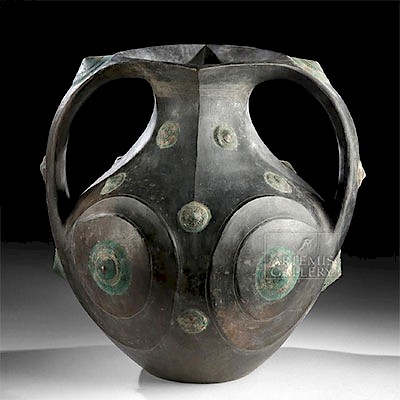Roman Bronze Three-Nozzle Oil Lamp w/ Chain
Lot 50
About Seller
Artemis Fine Arts
686 S Taylor Ave, Ste 106
Louisville, CO 80027
United States
Selling antiquities, ancient and ethnographic art online since 1993, Artemis Gallery specializes in Classical Antiquities (Egyptian, Greek, Roman, Near Eastern), Asian, Pre-Columbian, African / Tribal / Oceanographic art. Our extensive inventory includes pottery, stone, metal, wood, glass and textil...Read more
Estimate:
$3,500 - $5,000
Absentee vs Live bid
Two ways to bid:
- Leave a max absentee bid and the platform will bid on your behalf up to your maximum bid during the live auction.
- Bid live during the auction and your bids will be submitted real-time to the auctioneer.
Bid Increments
| Price | Bid Increment |
|---|---|
| $0 | $25 |
| $300 | $50 |
| $1,000 | $100 |
| $2,000 | $250 |
| $5,000 | $500 |
| $10,000 | $1,000 |
| $20,000 | $2,500 |
| $50,000 | $5,000 |
| $100,000 | $10,000 |
| $200,000 | $20,000 |
About Auction
By Artemis Fine Arts
Jul 11, 2019
Set Reminder
2019-07-11 10:00:00
2019-07-11 10:00:00
America/New_York
Bidsquare
Bidsquare : Ancient / Ethnographic / Americana
https://www.bidsquare.com/auctions/artemis-gallery/ancient-ethnographic-americana-4246
Discover ancient art from Egypt, Greece, Italy, and the Near East, as well as Asian, Pre-Columbian, Tribal, Fossils and Fine Art. Also featuring a wonderful collection from a prominent New York estate whose owners reside in the Van Wyck family's historic Lloyd Harbor waterfront home. Artemis Fine Arts info@artemisgallery.com
Discover ancient art from Egypt, Greece, Italy, and the Near East, as well as Asian, Pre-Columbian, Tribal, Fossils and Fine Art. Also featuring a wonderful collection from a prominent New York estate whose owners reside in the Van Wyck family's historic Lloyd Harbor waterfront home. Artemis Fine Arts info@artemisgallery.com
- Lot Description
Roman, early Imperial Period, ca. 1st to 2nd century CE. A beautiful bronze oil lamp cast via the lost wax (cire perdue) process and designed so that it could hang from the original chains attached to three pierced suspension tabs - one above each of the three nozzles - or sit on its flared foot. The scallop shell/spade-shaped nozzles are equidistantly placed around a central boss with concentric circles surrounding the protruding fill hole. Three chains rise from loops attached to the suspension tabs and meet at a central suspension loop. On top, around the lamp's outer perimeter is a raised decorative edge. A lamp like this, made of bronze and with multiple nozzles which burned more fuel, was costly and likely served as a status symbol for a wealthy family. Size: 7.5" W x 12.875" H (19 cm x 32.7 cm).
Some scholars have noted that bronze lamps, with their increased cost over pottery lamps, were most likely a type of heirloom, and were reserved for the richest households. Scholars believe that such bronze lamps remained in a family for at least three generations as they were coveted costly luxuries. Although metal lamps had a longer lifespan than lamps made of other materials, they were often melted down and reworked into other pieces. So having a complete example like this is rare.
Provenance: private East Coast, USA collection; ex-William Froelich collection, New York, USA, acquired in the 1970s
All items legal to buy/sell under U.S. Statute covering cultural patrimony Code 2600, CHAPTER 14, and are guaranteed to be as described or your money back.
A Certificate of Authenticity will accompany all winning bids.
We ship worldwide and handle all shipping in-house for your convenience.
#137158Repair to small exterior area of one nozzle, minor abrasions to lamp and foot, with slight bending to some chain links and suspension tabs, small nicks to top of lamp, and light encrustations. Nice earthen deposits as well as fabulous green and brown patina throughout.Condition
- Shipping Info
-
All shipping is handled in-house for your convenience. Your invoice from Artemis Gallery will include shipping calculation instructions. If in doubt, please inquire BEFORE bidding for estimated shipping costs for individual items.
-
- Buyer's Premium



 EUR
EUR CAD
CAD AUD
AUD GBP
GBP MXN
MXN HKD
HKD CNY
CNY MYR
MYR SEK
SEK SGD
SGD CHF
CHF THB
THB















